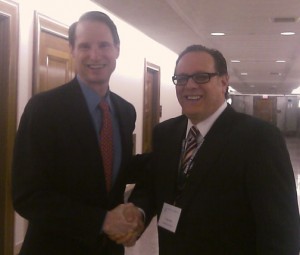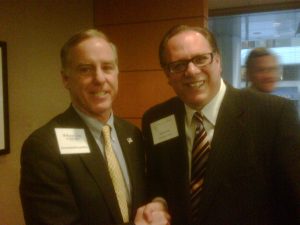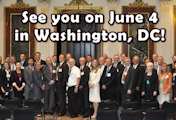Next Tuesday, April 20th, the NanoBusiness Alliance, the world’s leading nanotechnology trade association, will hold a special one-day event, NanoBusiness Conference/NYC http://www.nynanobusiness.org/ being held on the 5th floor of the Marriott Marquis hotel in Times Square.
Co-located with the NYBA (New York Biotechnology Association) Annual Meeting http://www.nyba.org/meeting/annualMeeting being held that week, the NanoBusiness Conference/NYC will feature a series of sessions with leaders in finance, government and science.
Click here http://www.nynanobusiness.org/agenda.php to view the agenda. Following will be a networking reception.
Register Today http://www.nynanobusiness.org/register.php
Today, we have the opportunity to share the thoughts one of the leaders in our Nanotechnology Community, Peter Hébert, Co-Founder and Managing Partner of Lux Capital. The interview was conducted by Author, Steve Waite.
Lux Capital’s http://www.luxcapital.com/, focus is on investments in advanced materials, energy technology and semiconductors. Peter began his career at Lehman Brothers, where he worked in the firm’s top-ranked Equity Research group. In 2000, he co-founded Lux Capital. In 2003, Peter led the spin-off of Lux Research. As founding CEO, he helped build Lux Research into the leading emerging technology research firm. Peter launched the publicly-listed Lux Nanotech Index [AMEX: LUXNI] and the $150 million PowerShares Lux Nanotech Portfolio [AMEX: PXN].
Peter manages Lux Capital’s investments in Accelergy, Angstrom Publishing, Everspin Technologies, Lux Research, Luxtera and several stealth energy ventures. He was a Chancellor’s Scholar and graduated cum laude from Syracuse University’s Newhouse School. Peter was the Founding President of Syracuse’s first venture organization, Future Business Leaders and Entrepreneurs. He has been an invited speaker, guest lecturer and panelist at CNBC, Bloomberg, Yale, Columbia, Cornell, MIT, and the National Science Foundation. Peter also co-founded Young Wall Street, a charitable organization supporting youth-related causes in New York City.
Lux Capital is one of the premier venture capital firms in nanotechnology. In this interview, we talk to Peter about what Lux Capital is up to these days and explore the nanotech landscape. We hope you enjoy the interview.
SW: Hey, Peter! It’s really great to speak with you today. Thanks for taking the time talk to us. I wanted to explore with you what’s going on with Lux Capital and discuss the nanotech investing and product commercialization landscape. Can you give us an update on what’s going on at Lux Capital today?
PH: Great talking with you as well Steve.
We’ve been extremely busy at Lux Capital over the past 12 months – creating new companies from scratch and backing early-stage companies with transformative technologies. With more than 20 active investments, we’re also spending a large portion of our time and energies working intimately with existing portfolio companies. This means helping with business development, product marketing, company positioning, recruiting management and of course preparing for future financings.
The world of nanotech investing has changed dramatically in the past 5 years. Most of the lower-quality, me-too ventures have exited stage left. A handful of segment leaders have consolidated their positions (both large corporations and start-ups). Throughout this winnowing process, we’ve seen great leaps forward in the commercialization of nanoscale science and technology. Whether it’s in life sciences, alternative energy or electronics – many of the most fundamental advances pushing new boundaries can be attributed to precise control of material properties at the molecular level.
Probably the biggest shift in nanotech has been from the initial focus on input materials to what our portfolio company Lux Research coined “nano-intermediates.” The initial focus on building blocks like nanotubes, nanowires and nanoparticles has evolved to developing higher value applications like batteries, solar PV and drug delivery systems.
SW: What are some of the more conventional nano-enabled innovations you are seeing at Lux Capital that may have a bright future in the market in the years ahead?
PH: Well, we’ve definitely moved beyond Dockers stain-proof pants and nano-enabled sun tan lotion! To be more specific, there is a wide-array of compelling nanotech products hitting the market in 2010. Nanosys is rolling out a quantum dot LED backlight for consumer electronics devices, with partner LG. Cambrios is using nanotechnology to replace rare earth metals Indium Tin Oxide (ITO) for touch screen devices found in mobile phone and tablet computers. Molecular Imprints is already shipping nano-imprint lithography machines to hard disk and semiconductor manufacturers.
SW: What are some of the unconventional nano-enabled technologies you have come across that you think deserve wider recognition?
PH: One interesting application is in the area of nanophotonics. Luxtera has pioneered and since commercialized the integration of complex optics and electronics onto a single nanoscale chip. Another Lux portfolio company Accelergy is using nanoscale catalysts to help convert abundant coal resources into cleaner liquid jet fuel, in partnership with ExxonMobil.
SW: A123 System’s IPO was a success last year and the company seems to be getting traction in the market. What are the prospects for nano-enabled batteries and storage technology?
PH: There will be huge opportunities in the energy storage – both for batteries and ultra-capacitors. A123 Systems really led the way, but there are a number of venture-backed start-ups dramatically changing the industry’s economics. Nanosys developed a proprietary additive for lithium ion battery anodes that enables its partners (battery cell makers) to improve capacity by more than 30%. Contour Energy Systems is another interesting VC-backed company in this area.
SW: Since I mentioned IPOs, let me ask you what Lux Capital’s view is on prospects for seeing more companies coming public with nano-enabled products in the near future?
PH: It’s obviously a question that is top of mind for most VCs. The answer is less about nano-enabled products and more about ramping revenues, great management teams and telling a story that resonates with Wall Street. A123 was able to tap the public markets because they were generating close to $100 million in annual revenues and the buy-side loved the electric vehicle and grid storage story.
SW: There was a time when Nanosys was seen as the premier nanotech company and there was a great deal of excitement about a Nanosys IPO. Lux Capital is an investor in Nanosys. How is the company doing these days?
PH: Nanosys has made tremendous progress over the last few years – but it has done so without using a megaphone. While Nanosys now boasts more than 700 patents, its biggest breakthrough was developing products that global customers are clamoring to buy. Its core business is now in two areas: LED lighting and batteries. Their LED backlighting innovation was covered extensively in recent articles by The Economist and Barron’s. Stay tuned for even more exciting news in the next several months.
SW: How does Lux Capital view the role of nanotech in the commercialization of clean technology? It seems to me there is tremendous opportunity for innovation with clean technology and nanotech. Have you seen anything in the nanomaterials space recently – in solar, for example, or elsewhere – that has knocked your socks off?
PH: There will be many great applications of nanotechnology in the area of alternative energy. Nanotech is poised to dramatically reduce cost for flexible, thin-film solar photovoltaics. That said, at Lux Capital, we believe solar PV is a challenging area for venture investment. The technologies are incredibly complex and finding a way to reliably manufacture the materials in high volumes has been a difficult – not to mention costly – odyssey. If all those challenges can be solved, you find yourself in a brutally competitive commodity market dictated almost entirely by price.
We put our money where our mouth was for two exciting energy applications we identified – both investments are today operating in stealth. The first company has pioneered a novel innovation in natural gas technology, while the second demonstrated world record energy efficiency in power conversion. We believe both technologies will leave industry insiders with their jaws on the floor, when announced.
SW: Semiconductors and microprocessors are going deeper into the nano realm. What types of innovations are you seeing in this space that will create more powerful chips in the future?
PH: Electronics has been probably the most aggressive industry to commercialize nanotechnology – and in truth, has been in the nano realm for a decade. We’re investors in Everspin, which leverages spin of an individual electron to form basis for electronic memory. We helped lead the company’s spinout from Freescale Semiconductor in 2008 and the business has had considerable revenue growth with global customers including Siemens and Emerson.
SW: We are seeing nanotechnology converging with biology. What kinds of innovations do you see emerging from the convergence and who are the researchers that are doing the most innovative work in this area?
PH: Nanotechnology isn’t just converging with biology – it is giving researchers a whole new understanding of how the body works and how we can better treat disease. The field of RNAi is hot in the scientific world. The research has garnered Nobel Prizes and has led to billions of dollars worth of start-up acquisitions by Big Pharma because it’s an area with tremendous potential. Yet, there is a massive challenge in being able to deliver RNAi and protect it from the body’s natural defense mechanisms. Many believe that nanotechnology is the best bet to be able to solve this critical problem.
More broadly, drug delivery is one of the main hot beds of innovative nanobiotech research. Dr. Robert Langer at MIT is rightfully referred to as one of the key pioneers in the field. His work continues to lead the way, but if you want to find some of the real rising stars in the area I’d look at some of his progeny like Dr. Justin Hanes at Johns Hopkins.
SW: The NIH has been financing a lot of nanotech-related cancer research. Are we likely to see some blockbuster nano-enabled cancer therapeutics in the near future?
PH: We invested in MIT-spinout Cerulean because we firmly believe the answer is “yes.” Cancer is a notoriously difficult opponent, but by using some of the advantages offered by nanotechnology, we can attack its few remaining weaknesses. Employing a sophisticated nano-architecture developed at MIT, Cerulean is able to deliver significant payloads directly into cancerous tumors, sparing the rest of the body from the awful toxicities associated with standard treatment.
SW: More broadly speaking, how does Lux Capital see nanotech impacting the pharmaceutical and biotechnology sectors in the years ahead? What areas do you see as the most attractive investment opportunities today?
PH: Nanotech approaches have already led to incrementally better drugs and this trend will absolutely continue in the years ahead. These improvements have led to successful new drugs, like Abraxane, making it to market providing better outcomes for patients and making billions for investors.
At Lux, we think the really big changes in store will be the result of technologies that deliver new functionalities. New ways of treating disease – not just marginally improving toxicity or increasing bioavailability. For example, one of our most recent stealth newcos has taken a counterintuitive approach to overcoming one of the body’s natural barriers and has demonstrated a first ever functionality never seen before in drug delivery.
SW: What are some of the more popular consumer products on the market that are nano-enabled and what kind of innovations are we likely to see in the years ahead?
PH: One breakthrough nano-enabled consumer product comes courtesy of the brilliant engineers at 60Ghz pioneer (and Lux investment) SiBEAM. The company’s fundamental breakthroughs at the nanoscale enabled multi-gigabit wireless home networking between consumer devices. You can find SiBEAM’s technology today in HDTVs at Best Buy from customers like Sony, Panasonic and later this year Vizio.
SW: What advice do you have for entrepreneurs exploring nanotech who are looking for funding?
PH: An entrepreneur can often feel like a brutal, fruitless journey. My advice is to remain persistent, listen to feedback and adapt, and most importantly, find customers who want your product.
SW: One last question. How are things going with the Forbes/Wolfe newsletter? Do you see the general investing public’s interest in nanotechnology rising in the future?
PH: We’ve had a great partnership with Forbes since 2002 and have recently expanded our relationship to publish articles on Forbes.com, publish a Weekly e-letter (Forbes Weekly Insider) and online blog (ForbesWolfe.com), as well as host a Video channel. I believe investors will remain enthusiastic about emerging technologies that have the potential to transform industries and marketplaces. Nanotech will be a major driver in that new reality.
SW: Thanks again for your time today, Peter. We wish you and your partners at Lux Capital continued success in the future.
PH: Thank you Steve. We could not be more excited!
I would like to thank Peter and Steve for their time and for sharing their insight with our Nanotechnology Community.
I look forward to seeing you in NYC on Tuesday.
Regards,
Vincent Caprio “It’s Green, It’s Clean, It’s Never Seen – That’s Nanotechnology”
www.vincentcaprio.org
Executive Director
NanoBusiness Alliance
203-733-1949
vincentcaprio@nynanobusiness.org







